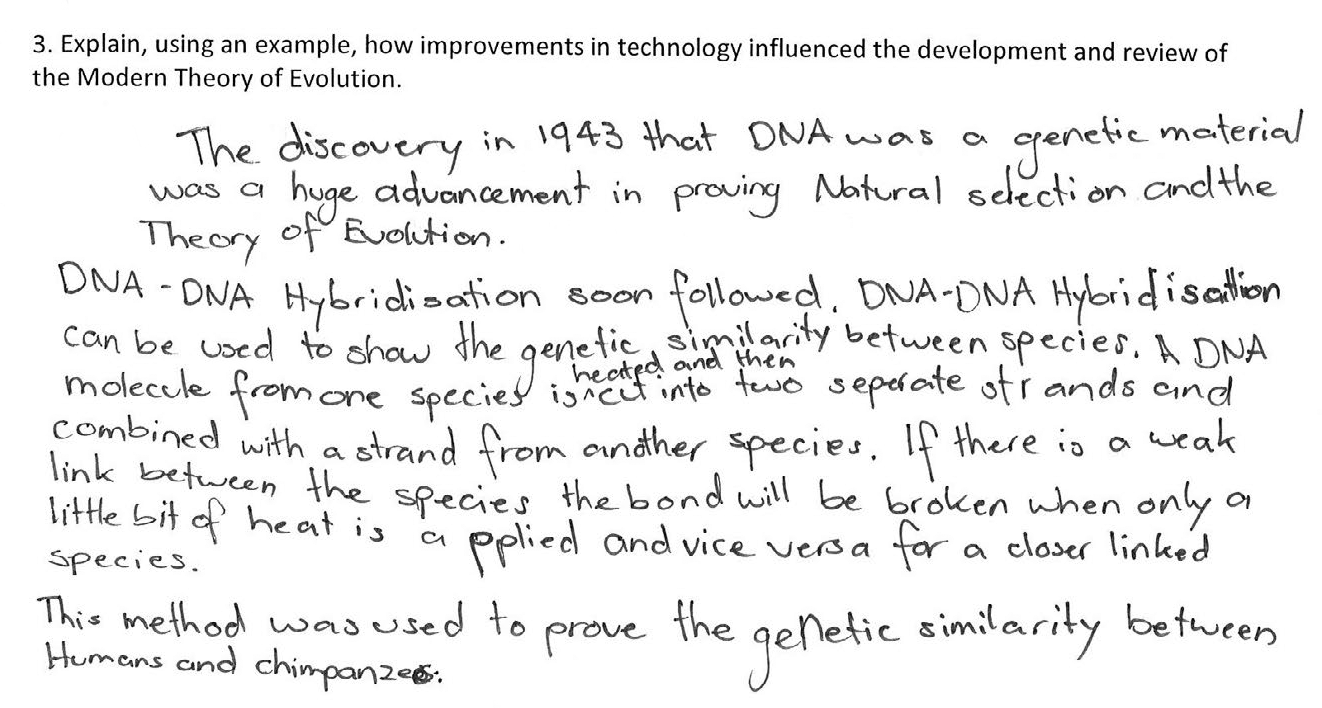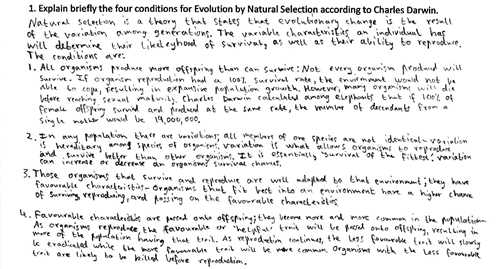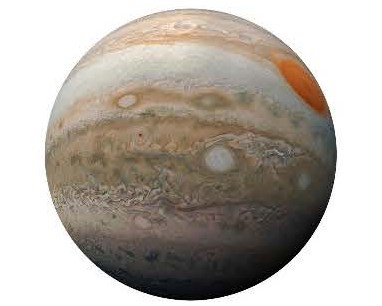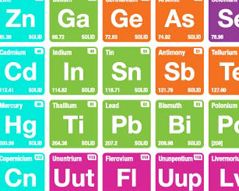- Home
- Resources
- Work samples
- Samples
- The theory of evolution by natural selection - ABOVE
Science
Year 10
Above satisfactory
The theory of evolution by natural selection
Summary of task
Students were asked to respond to questions about the principles and development of the theory of evolution.
Students had previously completed a unit of work in which early theories of evolution were discussed, as well as the theory of evolution by natural selection according to Charles Darwin and modern ideas about evolution. In this task, students worked individually to demonstrate their understanding of the theory, its development over time and its evidence base. They investigated how improvements in technology have influenced the development of the theory and researched the contribution of a scientist of their choice to the development of the theory.
Students completed a task booklet in response to selected questions. They were required to include a list of sources used in their research.
Achievement standard
By the end of Year 10, students analyse how the periodic table organises elements and use it to make predictions about the properties of elements. They explain how chemical reactions are used to produce particular products and how different factors influence the rate of reactions. They explain the concept of energy conservation and represent energy transfer and transformation within systems. They apply relationships between force, mass and acceleration to predict changes in the motion of objects. Students describe and analyse interactions and cycles within and between Earth’s spheres. They evaluate the evidence for scientific theories that explain the origin of the universe and the diversity of life on Earth. They explain the processes that underpin heredity and evolution. Students analyse how the models and theories they use have developed over time and discuss the factors that prompted their review.
Students develop questions and hypotheses and independently design and improve appropriate methods of investigation, including field work and laboratory experimentation. They explain how they have considered reliability, safety, fairness and ethical actions in their methods and identify where digital technologies can be used to enhance the quality of data. When analysing data, selecting evidence and developing and justifying conclusions, they identify alternative explanations for findings and explain any sources of uncertainty. Students evaluate the validity and reliability of claims made in secondary sources with reference to currently held scientific views, the quality of the methodology and the evidence cited. They construct evidence-based arguments and select appropriate representations and text types to communicate science ideas for specific purposes.
 1
Annotation 1
1
Annotation 1
Outlines main conditions and processes that underpin the theory of evolution by natural selection 2 Annotation 2
Constructs concise and logical argument based on deductive reasoning
-
Annotations
-
1
Annotation 1
Outlines main conditions and processes that underpin the theory of evolution by natural selection -
2
Annotation 2
Constructs concise and logical argument based on deductive reasoning
 1
Annotation 1
1
Annotation 1
Lists important events in Darwin’s career relevant to development of his theory 2 Annotation 2
Includes first written but unpublished formulation of Darwin’s ideas 3 Annotation 3
Recognises contributions of Darwin’s competitor and collaborator Alfred Wallace 4 Annotation 4
States key event that first publicised the idea of evolution by natural aelection among scientific community 5 Annotation 5
Lists key publication that explains evolution by natural selection 6 Annotation 6
Acknowledges public controversy following Darwin’s publication 7 Annotation 7
Lists scientific discoveries that provide basis for modern theory of evolution
-
Annotations
-
1
Annotation 1
Lists important events in Darwin’s career relevant to development of his theory -
2
Annotation 2
Includes first written but unpublished formulation of Darwin’s ideas -
3
Annotation 3
Recognises contributions of Darwin’s competitor and collaborator Alfred Wallace -
4
Annotation 4
States key event that first publicised the idea of evolution by natural aelection among scientific community -
5
Annotation 5
Lists key publication that explains evolution by natural selection -
6
Annotation 6
Acknowledges public controversy following Darwin’s publication -
7
Annotation 7
Lists scientific discoveries that provide basis for modern theory of evolution
 1
Annotation 1
1
Annotation 1
Selects specific technological advancement that was crucial in providing evidence for theory of evolution on a molecular level 2 Annotation 2
Explains how selected technology works 3 Annotation 3
Explains how selected technology was used to provide evidence for theory of evolution
-
Annotations
-
1
Annotation 1
Selects specific technological advancement that was crucial in providing evidence for theory of evolution on a molecular level -
2
Annotation 2
Explains how selected technology works -
3
Annotation 3
Explains how selected technology was used to provide evidence for theory of evolution
 1
Annotation 1
1
Annotation 1
Selects a competitor and collaborator of Charles Darwin 2 Annotation 2
Describes how Alfred Wallace’s influence on Charles Darwin contributed to development of modern theory of evolution
-
Annotations
-
1
Annotation 1
Selects a competitor and collaborator of Charles Darwin -
2
Annotation 2
Describes how Alfred Wallace’s influence on Charles Darwin contributed to development of modern theory of evolution
 1
Annotation 1
1
Annotation 1
Explains how fossils provide evidence in support of theory of evolution 2 Annotation 2
Describes two methods used to gather data on age of fossils 3 Annotation 3
Gives illustrated example of how evolution of a species can be derived from two types of fossil records 4 Annotation 4
Links physical appearance of fossils to species’ behaviour and environment at different stages of evolution
-
Annotations
-
1
Annotation 1
Explains how fossils provide evidence in support of theory of evolution -
2
Annotation 2
Describes two methods used to gather data on age of fossils -
3
Annotation 3
Gives illustrated example of how evolution of a species can be derived from two types of fossil records -
4
Annotation 4
Links physical appearance of fossils to species’ behaviour and environment at different stages of evolution
 1
Annotation 1
1
Annotation 1
Constructs evidence-based argument in support of evolution by natural selection 2 Annotation 2
Lists examples from microbiology that provide direct evidence for evolution by natural selection 3 Annotation 3
Presents further examples providing indirect evidence for evolution by natural selection
-
Annotations
-
1
Annotation 1
Constructs evidence-based argument in support of evolution by natural selection -
2
Annotation 2
Lists examples from microbiology that provide direct evidence for evolution by natural selection -
3
Annotation 3
Presents further examples providing indirect evidence for evolution by natural selection
 1
Annotation 1
1
Annotation 1
Reflects on merits of two different sources used to research the topic
-
Annotations
-
1
Annotation 1
Reflects on merits of two different sources used to research the topic






